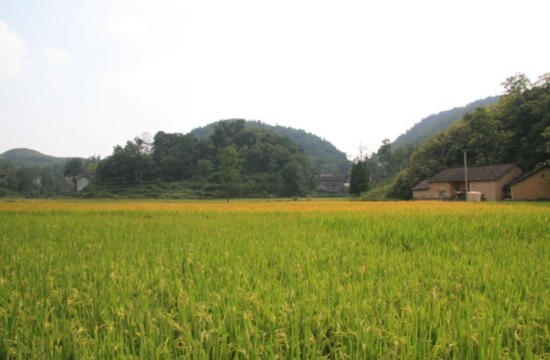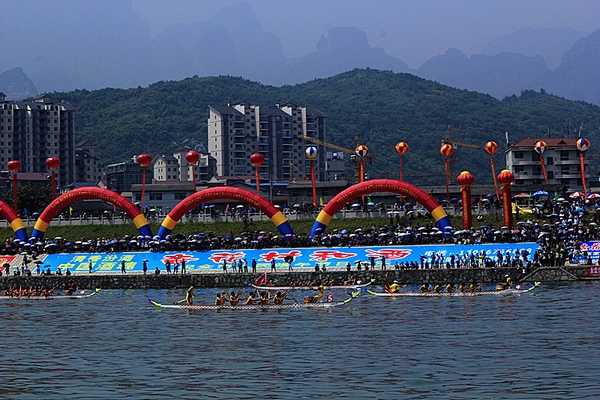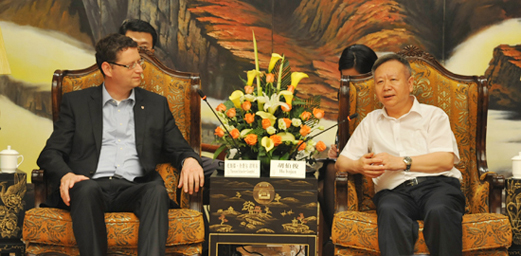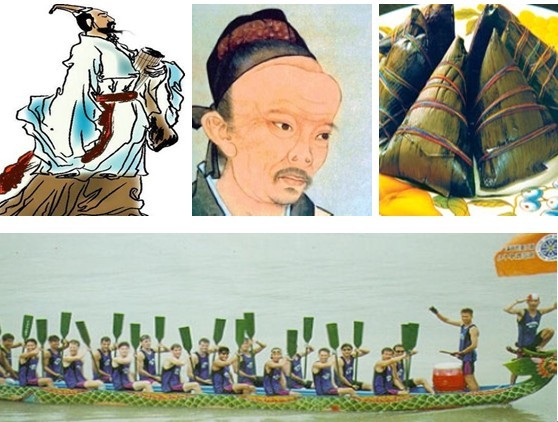-

Miao people are well versed in finding a good place to live, or hide, to be more precise. A track into a Miao village in the deep mountains of Xiangxi Tujia and Miao Autonomous Prefecture in northwestern part of Hunan province has proved the conclusion positively true."Miao People's Valley", or "Miao Ren Gu" in Chinese, is situated some 18 kilometers from Phoenix town, but the difference between the two tourist sites is striking.While Phoenix town is easily accessible and bears obvious marks of modernization, Miao People's Valley probably wouldn't be shown on a regional map and more than one third of its inhabitants don't have a television.According to local villagers, their ancestors settled here to stay away from the bandits using the mountains and the rivers as cover. They never thought that what used to protect them would hinder the development of the village now.But in recent years, travel buses began to transport packs of tourists to the village. Although it is one hour's bumpy ride from Phoenix town, they consider it worthwhile to experience the unspoiled Miao ethnic culture and breathtaking natural scenery.We were struck speechless by the idyllic sight when we arrived at the village gateway. Squares of rice swayed simultaneously with the wind, the tips of the plants beginning to turn golden. Stone houses with gray roofs scattered in the open field. Hardly any people, dogs and hens roam about indolently while strings of red chili and corn hang on the walls to dry.However, we are not in the center of the village yet. You have to take a bamboo raft and flow down to a huge cave before taking another boat to the other side of the mountain. The cave belonged to the head of the Miao village in ancient times. There is a buffalo skull hung on the banner of the cave gate to show the dominance of the leader.The cave is dark and damp, the channel is narrow. Water drips from overhead and occasionally we encounter waterfalls pouring down from high up on the stone walls.When we emerge into the sunlight again, we see an open lake, like a gem embedded in the mountains. After around five minutes of rowing on the lake, we arrive at the small Miao village.Girls and boys dressed in Miao costumes wait at the entrance, singing a folk song to welcome us. It is a tradition for the Miao people to welcome their guests with a song and in return, the guests should also sing back. They offer us homemade rice wine before we step into their homes. Low in alcohol and rich in fruit flavor, the rice wine tastes sweet and sour.They also show us their unique stunt - playing tunes using tree leaves. Our guide says that in Miao villages, girls and boys are free to choose their own partners when they are 16 years old. And a boy would show his affection for his girl by playing tree leaves tunes to her. So the feat is actually part of the matchmaking ritual for young lovers of the Miao ethnic minority and most men know how to play.To outsiders like us, the skill is incomprehensible, just like the lyrics of the Miao ethnic songs and dances that they perform for tourists. A large number of young people in the village are working as performers under a local tourism company. Long Faqiu's son is one of them.Long Faqiu, a local villager, serves homemade Miao cuisines to tourists. Although he mainly works on his farmland, he is receiving more and more benefit from the emerging tourism in Miao People's Valley. His annual income has doubled from years before the village was opened to travelers.On asking about whether he would go to live in big cities when he earned enough money, the middle aged man answered honestly that he wouldn't. What has drawn those city people here is something that you can't buy with money, as Long explained.Indeed, the pristine lifestyles of Miao people here is admired by travelers and their loyalty to tradition is something city dwellers do not possess.My wish upon leaving the village is not that I could stay longer, but that our visit, or any other tourist's visit in the future, does not taint the originality of Miao People's Valley and its residents.The pristine vistas of the Miao People's Valley.A buffalo skull is hung on the banner of the stone cave gate to show the dominance of the Miao leader.Tourists have to get on a bamboo raft and flow to the entrance of the stone cave before entering the village.Water drips down from the stone walls of the cave.Girls dressed in Miao costumes offer us homemade rice wine to welcome us.A woman with her small child in the wooden basket on her back, walks down the cobble stone path in Miao People's Village.Source from China.com.cn arranged by Aileen
News
2012-06-28 21:06
View:1980
-
![Fenghuang tourism in the Dragon Boat Festival[Photo Gallery]](/attachments/2012/07/2_201207082037301Ff2L.jpg)
News
2012-06-27 20:36
View:3705
-

June 30th is scheduled to mark the unveiling of a magic lantern show at Yaowang Temple on Haoyun Hill in Hongjiang Ancient Commercial Town. The show will open with the indigenous labor song " Yuanjianghaozi" in the ancient town known as "Pearl of Western Hunan". The story of "A Self-made Stranger" will be staged, presenting visitors with the magnificence of the torrent Yuanshui River, alterations in the commercial town and ups and downs of an immigrant merchant. The blessing lantern show is planned to be held every Saturday and will be free to tourists with entrance tickets to the scenic area. Translator: Guo Yan Source: Hunan Official Web Portal
News
2012-06-26 20:02
View:1471
-

Chinese Dragon Boat Festival, also called the Duanwu Festival, is celebrated on the fifth day of the fifth month according to the Chinese calendar. For thousands of years, the festival has been marked by eating zong zi and racing dragon boats. Every year, the dragon boat event held at the foot of the Tianmen mountain, Lishui river in zhangjiajie city.
News
2012-06-25 00:03
View:3683
-

Hu Bojun, secretary of the CPC Zhangjiajie Municipal Committee, welcomes the delegation for their inspection visit to Zhang Jiajie.The two sides exchange souvenirs.Secretary of the CPC Zhangjiajie Municipal Committee Hu Bojun met with the delegation of the Social Democratic Party of German (SPD) led by Thorsten Schafer-Gümbel, Hessian SPD regional chairman on the evening of Jun. 21.Hu extended his welcome to the delegation for their inspection visit to Zhangjiajie. He introduced that Zhangjiajie has various laurels such as the first batch of World Natural Heritage in China and the first batch of world geological parks. With three thousand gorgeous stiff cliffs and eight hundred beautiful water scenes, it is an unusual place of abundant tourism resource. He expected the delegation to provide guidance and help to Zhangjiajie from an international point of view and to introduce and popularize charming Zhangjiajie to German. He also hoped that both sides will strengthen economic and cultural exchange and cooperation.Thorsten Schafer-Gümbel said that Zhangjiajie is well-known at home and abroad. It has established friendly relationship with Hessian Geological Park of Germany. He will not only continue promoting the mutual cooperation, but also make the glamour of Zhangjiajie known to more German people. He also expected further in-depth cooperation opportunities between the two sides.Translator: Hao JingruSource: Hunan Official Web Portal
News
2012-06-24 23:59
View:1144
-

The 2012 Changsha Hunan Cuisine Week opens on June 23 in Changsha as a part of the 2012 Hunan Cuisine Industry Promotion Week to highlight hundreds of new Hunan dishes and special offers provided by hundreds of hotels and restaurants in the city.The event is taking place through June 30th, during which time 23 internationally acclaimed chefs, hailing from 9 countries including America, Britain, Spain, Netherlands, Japan, Switzerland, and Peru, will exchange cooking skills with top Hunan cuisine chefs in Changsha.Translator: Liu FenSource: Hunan Official Web Portal
News
2012-06-23 23:56
View:1239
-

Photo Source Location: Zhangjiajie National Forest Park (Huangshi Village Scenic Area)Source: Zhangjiajie Official Web Portal
News
2012-06-23 12:51
View:4513
-

5th day of the 5th lunar month The Dragon Boat Festival, also called the Duanwu Festival, is celebrated on the fifth day of the fifth month according to the Chinese calendar. For thousands of years, the festival has been marked by eating zong zi (glutinous rice(糯米)wrapped to form a pyramid using bamboo or reed leaves) and racing dragon boats. The festival is best known for its dragon-boat races, especially in the southern provinces where there are many rivers and lakes. This regatta(赛舟会)commemorates the death of Qu Yuan , an honest minister who is said to have committed suicide by drowning himself in a river. Qu was a minister of the State of Chu situated in present-day Hunan and Hubei provinces, during the Warring States Period (475-221BC)(战国时期). He was upright, loyal and highly esteemed for his wise counsel that brought peace and prosperity to the state. However, when a dishonest and corrupt prince vilified Qu, he was disgraced and dismissed from office. Realizing that the country was now in the hands of evil and corrupt officials, Qu grabbed a large stone and leapt into the Miluo River on the fifth day of the fifth month. Nearby fishermen rushed over to try and save him but were unable to even recover his body. Thereafter, the state declined and was eventually conquered by the State of Qin. The people of Chu who mourned the death of Qu threw rice into the river to feed his ghost every year on the fifth day of the fifth month. But one year, the spirit of Qu appeared and told the mourners that a huge reptile(爬行动物)in the river had stolen the rice. The spirit then advised them to wrap the rice in silk and bind it with five different-colored threads before tossing it into the river. During the Duanwu Festival, a glutinous rice pudding called zong zi is eaten to symbolize the rice offerings to Qu. Ingredients such as beans, lotus seeds(莲子), chestnuts(栗子), pork fat and the golden yolk of a salted duck egg are often added to the glutinous rice. The pudding is then wrapped with bamboo leaves, bound with a kind of raffia and boiled in salt water for hours. The dragon-boat races symbolize the many attempts to rescue and recover Qu's body. A typical dragon boat ranges from 50-100 feet in length, with a beam of about 5.5 feet, accommodating two paddlers seated side by side. A wooden dragon head is attached at the bow, and a dragon tail at the stern(船尾). A banner hoisted on a pole is also fastened at the stern and the hull is decorated with red, green and blue scales edged in gold. In the center of the boat is a canopied shrine behind which the drummers, gong(铜锣)beaters and cymbal(铙钹)players are seated to set the pace for the paddlers. There are also men positioned at the bow to set off firecrackers, toss rice into the water and pretend to be looking for Qu. All of the noise and pageantry creates an atmosphere of gaiety and excitement for the participants and spectators alike. The races are held among different clans, villages and organizations, and the winners are awarded medals, banners, jugs of wine and festive meals. Source:Chinadaily
News
2012-06-22 11:11
View:2279

![Fenghuang tourism in the Dragon Boat Festival[Photo Gallery]](/attachments/2012/07/2_201207082037301Ff2L.jpg)










